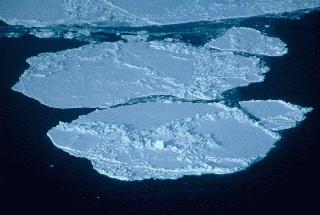Click on image for full size
NOAA Corp Collection, Photographer Michael Van Woert
Related links:
Movie showing Yearly Changes of Sea Ice Extent in the Arctic
Movie showing Yearly Changes of Sea Ice Extent in the Antarctic
Compare Images of Arctic Sea Ice Extent Side-by-side
Compare Images of Antarctic Sea Ice Extent Side-by-side
Activity: Graphing Sea Ice Extent in the Arctic and Antarctic
Polar Oceans
There are two oceans in Earth's polar regions.
- The Arctic Ocean is in the north polar region.
- The Southern Ocean is in the south polar region.
The oceans that are in the polar regions are a bit different from other oceans on Earth. There is often sea ice at their surface, especially during the winter months. And those chilly waters are home to some unique marine life.
Seawater from polar regions can be denser than seawater from other places. This is because seawater in the polar oceans is cold, and this makes it denser. It can also become saltier than other seawater during the winter when sea ice freezes at the ocean surface removing some of the freshwater to make the ice, which concentrates the salts. The denser seawater sinks to the bottom of the ocean. It travels out of the polar regions in slow currents that travel around the bottom of the world’s oceans as part of the pattern of global ocean circulation called thermohaline circulation.
The polar oceans are warming up as Earth’s climate changes. Scientists are studying how the polar oceans, the sea ice at their surface, and the marine life within them, are changing in response to recent climate change. They have found that sea ice in the Arctic Ocean is melting so quickly that by the year 2040 there may not be any sea ice in the Arctic during summer months. The melting sea ice threatens Arctic Ocean species such as polar bears. In the Antarctic, scientists are studying the effect of less sea ice on the penguin breeding season.
If it gets warm enough that polar oceans are warmer and sea ice no longer forms, the seawater would not be as dense and would not flow down to the ocean bottom, potentially slowing or stopping global ocean circulation. If the oceans stopped their pattern of global circulation, many aspects of our planet would change including regional climates, the severity of weather events, and marine ecosystems.














